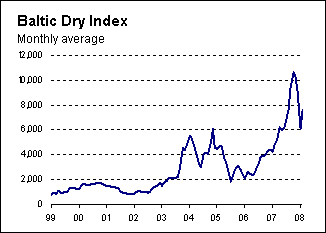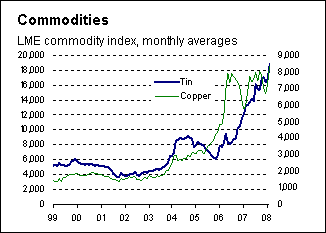Commodity prices: what does the Baltic Dry Index tell us?
Many financial analysts view the current slide in the ‘Baltic Dry Index’ as indicative of an upcoming collapse in commodity prices, however we do not believe the story is quite that clear cut.
The Baltic Dry Index is a composite index which tracks the cost of shipping iron, coal, and wheat based on the appraisal of a panel of professionals.
As the supply of ships and port machinery takes a long time to respond to any changes in price, sudden shifts in the index are assumed to be the result of a change in demand for dry commodities (wood, copper, iron, coal, and wheat).
This index is an important indicator for New Zealand as it gives us an idea of world economic activity. Often analysts infer that a significant increase in the index suggests an increase in world investment and construction.
Between November and January, the Baltic Dry Index slipped 48%, as rates for shipping have fallen (see Graph 7.1). There was some recovery in February, but the index still remains well off its peak in November.

Graph 7.1
There are two different stories for the recent movement in the Baltic dry index: the pessimistic story and the optimistic story.
The pessimistic story
The pessimistic story puts the index’s fall solely down to a reduction in demand for dry commodities. If the dip is the result of a fall in demand for dry commodities, and nothing else, then it spells potential problems for New Zealand for two reasons. Firstly, a slide in demand for dry commodities would depress already low log and timber prices. More importantly, a fall in demand for these commodities may imply a slowing inworld economic growth, putting downward pressure on prices for our soft commodity exports (i.e. meat and dairy products).
However, this story is inconsistent with the actual movements in commodity spot prices. The price of many dry commodities fell very slightly (if at all) over December and January (see Graph7.2), indicating that underlying demand for these commodities was still strong when the Baltic Dry Index declined.

Graph 7.2
The optimistic story
Another popular story states that the Baltic Dry Index has eased as the result of negotiations between ore supplier sand transport companies. In this case, a temporary reduction in ore has reduced the demand for transport from the suppliers, and once these negotiations are over the index will move back to its previous highs.
If this is the case, New Zealand has nothing to worry about, because world economic growth remains strong, and the cost of shipping our logs and timber overseas is temporarily lower – an added bonus.
Yet if this is the case, why didn’t the price of dry commodities shoot upwards? If the volume of ore supplied to the market has fallen then, all other things being equal, the spot price of ore should increase.
Conclusion
As a result, it seems that we are experiencing a mix of both stories. Overall demand for dry commodities is easing, and suppliers are limiting volumes. Together these factors have driven a significant reduction in the Baltic Dry Index.
Overall, this is a negative story for New Zealand, but not to the degree that some analysts are portraying. The significant dip in the index does indicate that demand for commodities are beginning to ease, but the current constraint on the supply of some goods suggests that the slip in the index overstates the weakness in commodities.
 Matt Nolan
Matt Nolan



